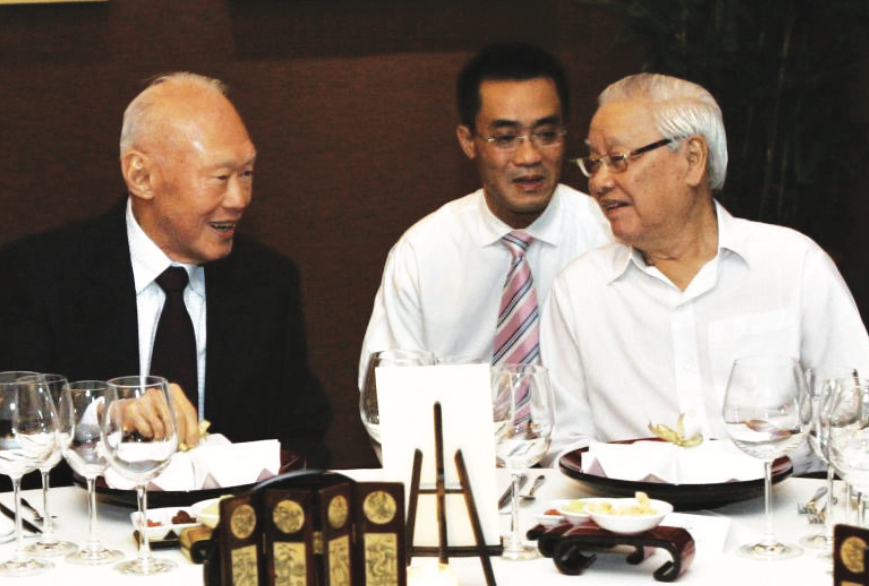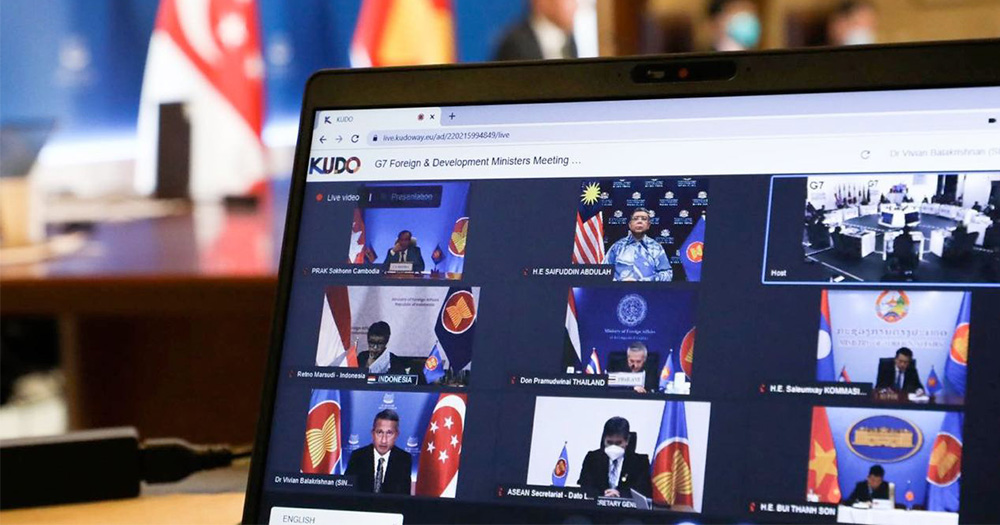Follow us on Telegram for the latest updates: https://t.me/mothershipsg
George Yeo: Musings is a collection of just that: The former foreign minister’s musings across various diverse topics.
Series One, the first of three books, contains Yeo’s thoughts about identity, Singapore’s diversity, and how this affects the country’s relationships with the rest of the world, including China and India.
The book is written by Yeo, with Woon Tai Ho, and published by World Scientific. It will be available at all major bookstores from September 2022, but Mothership readers can pre-order a copy here with the promo code “WSMSGY20” and get 20 per cent off.
An excerpt from Chapter 11, “The People's Republic”, is reproduced here.
By George Yeo, with Woon Tai Ho
As China moves to centre stage in global politics and economics, the relationship between China and diaspora Chinese will naturally grow stronger. Chinese communities which lost their connection to China (like the Peranakans of Indonesia, Malaysia and Singapore) are finding renewed interest in Chinese heritage and language.
In the U.S. today, American Chinese working in science, technology, engineering and mathematics (STEM) have suddenly found themselves under surveillance or suspicion by the Federal Bureau of Investigation (FBI) because of worsening relations between the U.S. and China. In 2018, the Director of the FBI, Christopher Wray, said that the U.S. was concerned with “the China threat as not just a whole-of-government threat, but a whole-of-society threat on their end", which requires “... a whole-of-society response by us”. In a speech at the Ronald Reagan Presidential Library in January 2022, Wray stressed again, “I want to focus on it here tonight because it’s reached a new level — more brazen, more damaging, than ever before, and it’s vital, vital that all of us focus on that threat together.”
In Southeast Asia, ethnic Chinese have gone through difficult periods in the past. After South Vietnam fell to the North in 1975, the first waves of boat people were mostly Chinese. Under Suharto, Indonesia banned Chinese language and literature, probably the only country in the world to do such a thing. I remember reading with disgust customs forms which stated that, along with drugs and firearms, Chinese-language material was also considered contraband. In Thailand, those of Chinese descent were not allowed to join the Army (although many still did).
Anti-Chinese sentiment in Southeast Asia
The main cause of anti-Chinese sentiment in Southeast Asia is the disproportionate role ethnic Chinese play in business. Among the very wealthy, many are ethnic Chinese. Some are known for their philanthropic work like Lee Kong Chian’s family, but a few behave badly and live ostentatiously. Thailand’s King Rama VI criticised the ethnic Chinese as the “Jews of the East” even though his own ancestor, Rama I, had Chinese blood.
They are also seen as being disloyal or not loyal enough. Overseas Chinese supported China’s resistance against increasing Japanese encroachment into the Chinese mainland from the early 1930s. Tan Kah Kee organised the Nanyang Federation of China Relief Fund Technicians. From 1939 to 1942, over 3,000 overseas Chinese volunteered as truck drivers and mechanics in China along the Rangoon–Yunnan Road. About 1,800 technicians died from bombing, disease and exhaustion. His nephew, Tan Keong Choon, raised money to build a memorial by Dian Lake near Kunming to remember their sacrifice. At the Ee Hoe Hean Club in Singapore, there is an interesting memorial hall to Tan Kah Kee and other Singapore Chinese leaders.
Japan viewed overseas Chinese communities in Southeast Asia as extensions of China. Japan’s invasion of Southeast Asia was carefully planned for years before it was executed in December 1941.
Plans for the Malayan Campaign were made in Taiwan (which Japan took from Qing China in 1895). In his book The Killer They Called a God, Ian Ward writes about how Lieutenant Colonel Masanobu Tsuji drew up a detailed plan to eliminate many overseas Chinese once the Japanese Army had occupied Singapore. Post-war sources revealed that the order was to kill 50,000. The Japanese referred to the Sook Ching as the Kakyō Shukusei (華僑粛清), meaning purging of overseas Chinese. Sook Ching was second only to Nanjing in the cruelty inflicted on a civilian population.
During the Japanese occupation of Malaya, the Malayan Peoples’ Anti-Japanese Army (MPAJA), led by the Communist Party of Malaya (CPM), fought a guerilla war against the Japanese in the jungle. They were mostly Chinese. Between the Japanese surrender on Aug. 15, 1945 and the return of British forces in September that year, the MPAJA took action against Japanese collaborators, many of whom were Malay.
Ultimately, the failure of the CPM struggle in Malaya was due to their inability to win over the Malays, who expressed their nationalism through the United Malays National Organisation (UMNO).
The Malayan Emergency will eventually be seen in the historical context as a nationalist struggle which failed because of racial division which the British exploited. Many young men lost their lives in pursuit of a righteous cause. Robert Kuok burns a joss stick everyday for his second brother, who was killed by the British during the Emergency and whom he admired for his good heartedness, brilliance and eloquence.
In both Malaya and Singapore, the British were determined to hand power over to credible nationalist groups who were less unfriendly to them. In Malaya, the proposal for a Malayan Union was changed to one for the Malayan Federation, enshrining the position of the Sultans and Malay rights. In Singapore, the British favoured Lee Kuan Yew and his faction in the People's Action Party (PAP). Both direct and indirect British interventions at critical moments were decisive. The British did not want an independent Singapore because it could become a satellite of China. They manoeuvred for Singapore to gain independence through the merger with Malaysia.
Lee Kuan Yew later said that Sarawak and Sabah were the dowry the British gave to the Tunku to admit Singapore into Malaysia. When the Tunku agreed two years later that Singapore could go free, Lee Kuan Yew wrote that he kept it a closely-guarded secret from the British until it was irreversible because they would have thwarted it.
Although many ethnic Chinese in Southeast Asia threw themselves into nationalist struggles against the colonial enemy, like the Philippines’ José Rizal, as a group they were sometimes seen to be less supportive, as in Indonesia, or too aligned with China-backed communist movements, as in Thailand and Malaya.
Projecting unhappiness on Singapore
When, for whatever reason, countries in Southeast Asia are unhappy with their indigenous Chinese populations, they project their unhappiness on Singapore as a headquarters for Southeast Asian Chinese.
Whatever we say or do, the fact is that many countries factor Singapore’s Chineseness into their planning and calculations. For this reason, Lee Kuan Yew held back diplomatic relations with China until Indonesia had done so. To some extent, we have succeeded in convincing other countries that while Singapore has close cultural ties to China, on political matters, we calculate in our own self-interest.
One day in the mid-1990s, Singapore’s relations with China went through a bad patch. Indonesian Foreign Minister Ali Alatas expressed his concern about the state of Singapore–China relations to me, and indirectly offered his assistance. I was pleasantly surprised that here was Indonesia worried that we were having bad relations with China.
For a period, Vietnam viewed us with suspicion too. After Vietnamese divisions moved into Cambodia in 1978, Singapore, together with other Association of Southeast Asian Nations (Asean) countries, worked with China to support anti-Vietnam forces in Cambodia. (Unlike China and Thailand, Singapore kept a distance from the Khmer Rouge but supported all other factions.) At the United Nations and other international gatherings, we combined efforts to deny legitimacy to the government in Phnom Penh installed by Vietnam. After 10 years, Vietnam withdrew from Cambodia. They then decided to follow China in gradually opening up its economy.
Prime Minister (PM) Vo Van Kiet visited Singapore in 1991. At the end of a dinner hosted by Lee Kuan Yew at the Istana, Kiet asked Lee Kuan Yew to be an adviser to Vietnam. Although he was taken aback and promised to visit Vietnam regularly, he did not agree to become an adviser.
 Lee Kuan Yew and Vietnam Communist Party General Secretary Vo Van Kiet at a dinner in the Istana in 1991, after which he asked Lee Kuan Yew to be Vietnam’s adviser. Image courtesy of George Yeo.
Lee Kuan Yew and Vietnam Communist Party General Secretary Vo Van Kiet at a dinner in the Istana in 1991, after which he asked Lee Kuan Yew to be Vietnam’s adviser. Image courtesy of George Yeo.
I accompanied Lee Kuan Yew on his first three trips to Vietnam. Relations steadily improved. The first Vietnam Singapore Industrial Project (VSIP), was a mini-Suzhou, established near Ho Chi Minh City in 1996. (Since then many VSIPs have sprouted across the length of Vietnam.) When I was Minister for Trade and Industry, I co-chaired a bilateral commission with the Vietnam Minister for Planning as my counterpart. Whenever meetings were held in Hanoi, I called on PM Phan Van Khai. He was always polite but somewhat formal until, one year, he spoke to me as if I was his minister and started giving me “homework”.
Something had happened. My belief was that Vietnam had come to the conclusion that Singapore was not an agent of China and could become a strategic partner. On Khai’s next visit to Singapore in 2004, the two countries launched the Connectivity Initiative, which I helped put together for Goh Chok Tong.
Image from the Prime Minister's Office via PM Lee's Facebook account
If you like what you read, follow us on Facebook, Instagram, Twitter and Telegram to get the latest updates.
